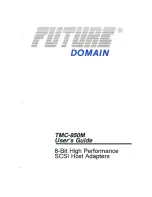
Fabric OS 5.2.x administrator guide 253
Port and switch naming standards
Fabric OS handles differences in port and switch naming rules between CUP and itself as follows:
•
CUP employs 8-bit characters in port address names and switch names; Fabric OS employs 7-bit
characters. When fmsmode is enabled, all characters greater than 0x40 and not equal to 0xFF
(EBCIDC code page 37 [0x25]) are allowed in the name; therefore, it is possible for a channel to set a
name with nonprintable characters. If a name contains nonprintable characters, they are displayed as
dots (...). The following characters are also displayed as dots: semicolon (;), comma (,),
“equal” sign (=), and “at” sign (@).
NOTE:
Configuration files that contain nonprintable characters should not be edited manually,
because many editors replace nonprintable characters with some other characters without warning
the user first.
•
CUP has a 24-character unique port name limitation; Fabric OS supports port names up to 32
characters long. When fmsmode is enabled, names longer than 24 characters are truncated.
•
To ensure that they are unique, the characters ~00, ~01, ~02, and so on are appended to port names.
•
CUP allows a 24-character switch name; Fabric OS limits the switch name to 15 characters. To
reconcile this difference, Fabric OS files the first 15 characters in the WWN record and stores the extra
characters for CUP use.
Adding and removing FICON CUP licenses
If fmsmode is enabled when the FICON CUP license is removed, the control device is reset. PDCM
enforcement continues. If fmsmode is disabled when the FICON CUP license is removed, no special action
is taken.
If fmsmode is enabled on a switch that does not have a FICON CUP license and then the license is
installed, you must first disable and then re-enable fmsmode. If fmsmode is disabled and a FICON CUP
license is installed, no special action is required.
Zoning and PDCM considerations
The FICON Prohibit Dynamic Connectivity Mask (PDCM) controls whether or not communication between
a pair of ports in the switch is prohibited or allowed. If there are any differences in restrictions set up with
Advanced Zoning and PDCM, the most restrictive rules are automatically applied.
All FICON devices should be configured in a single zone using the “Domain, Area” notation. PDCM can
then be used to “Allow” or “Prohibit” access between specific port pairs.
PDCM persists across a failover because it is replicated at all times to the standby CP blade. The active
PDCM configuration is saved to the IPL if the ASM bit is set on.
Zoning and link incident reporting
Non-implicit link incidents (such as NOS recognized or bit error rate threshold exceeded) that are related
to a specific port are reported to registered listeners only if they are in the same zone as the port for which
the link incident is being reported. As long as all FICON devices are in a single zone, link incidents for
FICON ports are reported only to registered FICON listener ports.
The only exception to this is the
loss of synchronization
link incident. Even though this link incident is related
to a specific port, it can be reported to a registered listener that is in a different zone.
Implicit link incidents (such as WWN card failure or power supply failure) that are not related to a specific
port are reported to registered listeners regardless of zoning configuration.
Backing up and restoring configurations
The Fabric OS
configUpload
command saves up to 16 FICON configuration files, including IPL files. For
details on the behavior of the
configDownload
command, refer to ”
Restoring configurations in a FICON
environment
” on page 122.
Содержание AE370A - Brocade 4Gb SAN Switch 4/12
Страница 1: ...HP StorageWorks Fabric OS 5 2 x administrator guide Part number 5697 0014 Fifth edition May 2009 ...
Страница 18: ...18 ...
Страница 82: ...82 Managing user accounts ...
Страница 102: ...102 Configuring standard security features ...
Страница 126: ...126 Maintaining configurations ...
Страница 198: ...198 Routing traffic ...
Страница 238: ...238 Using the FC FC routing service ...
Страница 260: ...260 Administering FICON fabrics ...
Страница 280: ...280 Working with diagnostic features ...
Страница 332: ...332 Administering Extended Fabrics ...
Страница 414: ...398 Configuring the PID format ...
Страница 420: ...404 Configuring interoperability mode ...
Страница 426: ...410 Understanding legacy password behaviour ...
Страница 442: ...426 ...
Страница 444: ......
Страница 447: ......















































